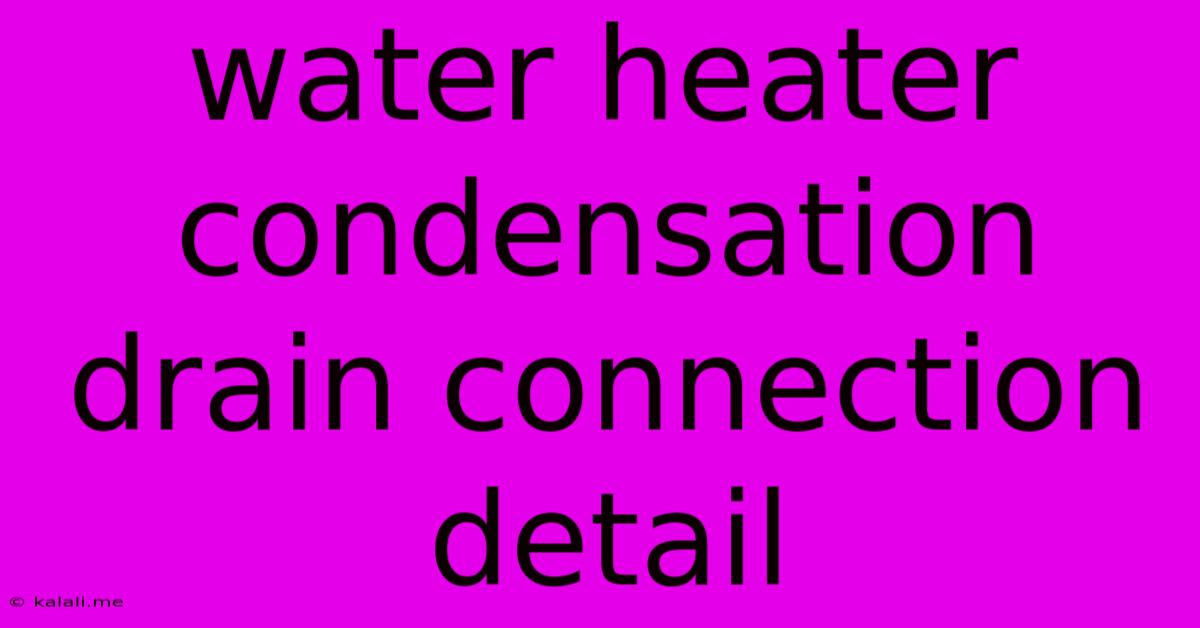Water Heater Condensation Drain Connection Detail
Kalali
Jun 03, 2025 · 3 min read

Table of Contents
Understanding and Connecting Your Water Heater Condensation Drain: A Comprehensive Guide
Meta Description: This guide provides a detailed explanation of water heater condensation drains, their importance, and how to properly connect them. Learn about different drain types and troubleshooting common issues.
Many modern water heaters, especially tankless models and some high-efficiency tank water heaters, produce condensation as a byproduct of their operation. This condensation, if not properly addressed, can lead to several problems, including water damage, corrosion, and even mold growth. Therefore, understanding your water heater's condensation drain connection is crucial for maintaining its efficiency and longevity. This article will provide a comprehensive guide to water heater condensation drain connections.
What is a Condensation Drain?
A condensation drain is a pipe that removes the condensed water produced by your water heater. This water is formed when hot, humid air from the combustion process comes into contact with cooler surfaces within or around the unit. Unlike traditional water heaters, which simply heat water, these models also produce water vapor that needs to be properly evacuated. Failing to do so can lead to significant issues.
Types of Condensation Drains
There are primarily two types of condensation drain connections:
-
Gravity Drain: This is the simplest type, relying on gravity to drain the condensation. The drain line is typically sloped downwards to a suitable drainage point, such as a floor drain or a condensate pump. This system requires minimal maintenance but is only suitable for situations where the drain point is easily accessible and lower than the water heater.
-
Condensate Pump: When gravity drainage isn't feasible, a condensate pump is used. This pump actively pumps the condensation to a higher or more distant location. Condensate pumps are often necessary for installations where the water heater is located in a basement or above the desired drainage point. These pumps require electrical connections and regular maintenance.
Connecting Your Water Heater Condensation Drain: A Step-by-Step Guide
Connecting your water heater's condensation drain properly is essential. While specific instructions may vary based on your water heater model, these general steps apply:
-
Identify the Drain Line: Locate the condensation drain line on your water heater. It's typically a small-diameter pipe, often PVC or CPVC.
-
Choose Your Drain Method: Decide whether a gravity drain or condensate pump is appropriate based on your setup and the location of your water heater.
-
Gather Materials: You'll need appropriate drain pipe, fittings (elbows, connectors), sealant (Teflon tape or pipe dope), and potentially a condensate pump and its associated wiring and connections.
-
Install the Drain Line: If using gravity, ensure the pipe is sloped at least 1/4 inch per foot. Securely connect the pipe to the water heater drain using appropriate fittings and sealant. Route the pipe to your chosen drainage point. Ensure proper ventilation to prevent build-up of sewer gases.
-
Connect the Condensate Pump (If Applicable): If using a pump, connect the inlet hose to the water heater drain and the outlet hose to the drainage point. Connect the pump to a power source according to the manufacturer’s instructions.
-
Test the Connection: After installation, run your water heater and check for leaks. Observe the flow of condensation to ensure the drain is working correctly.
Troubleshooting Common Problems
-
Clogged Drain: A clogged drain can lead to condensation buildup. Regularly check and clean the drain line to prevent blockages.
-
Pump Failure: If using a condensate pump, ensure it’s receiving power and functioning correctly. Listen for unusual noises or examine for any signs of malfunction.
-
Improper Slope: Insufficient slope in a gravity drain can lead to slow or incomplete drainage. Adjust the slope if necessary.
-
Leaks: Check all connections for leaks and re-seal as needed.
Conclusion:
Properly connecting your water heater's condensation drain is crucial for preventing damage and ensuring the efficient operation of your water heating system. By following this guide and addressing any potential problems promptly, you can maintain a safe and efficient home environment. Remember to consult your water heater’s installation manual for specific instructions relevant to your model.
Latest Posts
Latest Posts
-
Can I Use A Car Battery To Charge My Phone
Jun 05, 2025
-
How To Add Echo To Digits
Jun 05, 2025
-
Are Transporters In Star Trek Proof That Souls Exist
Jun 05, 2025
-
Whats Another Way To Describe Someone Whos Classess
Jun 05, 2025
-
How To Remove Snapchat Best Friends
Jun 05, 2025
Related Post
Thank you for visiting our website which covers about Water Heater Condensation Drain Connection Detail . We hope the information provided has been useful to you. Feel free to contact us if you have any questions or need further assistance. See you next time and don't miss to bookmark.